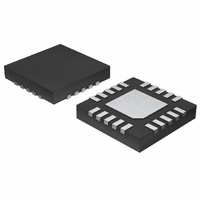MAX1980ETP+T Maxim Integrated Products, MAX1980ETP+T Datasheet - Page 19

MAX1980ETP+T
Manufacturer Part Number
MAX1980ETP+T
Description
IC CNTRLR QUICK-PWM 20-TQFN
Manufacturer
Maxim Integrated Products
Datasheet
1.MAX1980ETPT.pdf
(33 pages)
Specifications of MAX1980ETP+T
Pwm Type
Controller
Number Of Outputs
1
Frequency - Max
550kHz
Duty Cycle
50%
Voltage - Supply
4 V ~ 28 V
Buck
Yes
Boost
No
Flyback
No
Inverting
No
Doubler
No
Divider
No
Cuk
No
Isolated
No
Operating Temperature
0°C ~ 85°C
Package / Case
20-TQFN Exposed Pad
Frequency-max
550kHz
Input Voltage
4 V to 28 V
Mounting Style
SMD/SMT
Maximum Operating Temperature
+ 100 C
Minimum Operating Temperature
- 40 C
Lead Free Status / RoHS Status
Lead free / RoHS Compliant
The switching frequency and operating point (% ripple
or LIR) determine the inductor value as follows:
where
I
30% ripple current or LIR = 0.3:
Find a low-loss inductor having the lowest possible DC
resistance that fits in the allotted dimensions. Ferrite
cores are often the best choice, although powdered
iron is inexpensive and can work well at 200kHz. The
core must be large enough not to saturate at the peak
inductor current (I
where
The inductor ripple current affects transient-response
performance, especially at low V
Low inductor values allow the inductor current to slew
faster, replenishing charge removed from the output fil-
ter capacitors by a sudden load step. The amount of
output sag also is a function of the maximum duty fac-
tor, which can be calculated from the on time and mini-
mum off time:
where t
Electrical Characteristics),
and K is from Table 3.
The amount of overshoot due to stored inductor energy
can be calculated as:
LOAD
V
SAG
Driver Disable for Multiphase DC-DC Converter
η
= 40A, V
η
=
is the number of phases.
OFF(MIN)
is the number of phases. Example:
L
2η
L I
=
(
C
L
∆
12
OUT OUT
=
I
PEAK
LOAD MAX
1 3
V x
V
IN
V x f
.
IN
SOAR
V
PEAK
V x
______________________________________________________________________________________
V
= 12V, V
is the minimum off time (see the
300
(
OUT
=
SW
I
(
LOAD MAX
12
kHz x
):
≈
)
x V
)
(
V
(
x I
2
V
(
∆
IN
2η
-
LOAD MAX
IN
I
(
1 3
η
LOAD MAX
OUT
−
V
.
C
40
V
-
V
OUT
is the number of phases,
Transient Response
IN
V
V
OUT OUT
V x
OUT
IN
OUT
(
A x
Inductor Selection
)
)
= 1.3V, f
(
IN
K
2
)
V
+
K
2
)
0 3
)
+
- V
2η
x
.
Quick-PWM Slave Controller with
x LIR
LIR
)
η
t
-
)
OFF MIN
OUT
=
2
t
OFF MIN
L
0 64
SW
(
.
(
differentials.
µ
= 300kHz,
)
H
)
η
= 2,
The master and slave current-limit thresholds must be
great enough to support the maximum load current,
even under worst-case operating conditions. Since the
master’s current limit determines the maximum load
(see the Current-Limit Circuitry section), the procedure
for setting the current limit is sequential. First, the mas-
ter’s current limit is set based on the operating condi-
tions and the characteristics of the low-side MOSFETs.
Then the slave controller is configured to adjust the
master’s current-limit threshold based on the precise
current-sense resistor value and variation in the MOS-
FET characteristics. Finally, the resulting valley current
limit for the slave’s inductor occurs above the master’s
current-limit threshold. This is acceptable since the
slave’s inductor current limit only serves as a fail-safe in
case the master and slave inductor currents become
significantly unbalanced during a transient.
The basic operating conditions are determined using
the same calculations provided in any Quick-PWM reg-
ulator data sheet. The valley of the inductor current
(I
number of phases minus half of the peak-to-peak
inductor current:
where the peak-to-peak inductor current may be deter-
mined by the following equation:
The master’s high current-limit threshold must be set
high enough to support the maximum load current,
even when the master’s current-limit threshold is at its
minimum tolerance value, as described in the master
controller’s data sheet. Most Quick-PWM controllers
that may be chosen as the master controller use the
low-side MOSFET’s on-resistance to sense the inductor
current. In these applications, the worst-case maximum
value for R
R
the master’s current-limit threshold. A good general rule
is to allow 0.5% additional resistance for each °C of
temperature rise. Set the master current-limit threshold
to support the maximum load current for the maximum
R
LIMIT(VALLEY)
DS(ON)
DS(ON)
I
LIMIT VALLEY
V
ITHM(HIGH)
and minimum current-limit tolerance value:
over temperature must be used to determine
(
∆I
DS(ON)
INDUCTOR
) occurs at I
)
≥
≥ (I
plus some margin for the rise in
I
Setting the Current Limits
LOAD MAX
LIMIT(VALLEY)
=
V
η
(
OUT IN
LOAD(MAX)
V f
(
IN SW
)
V
−
)R
−
V
∆
L
DS(ON)(MAX)
OUT
I
INDUCTOR
divided by the
2
)
19











